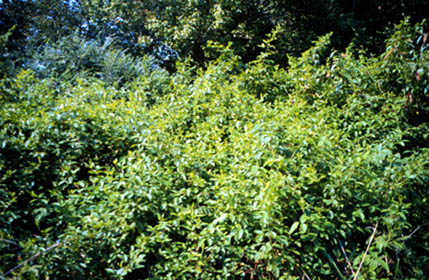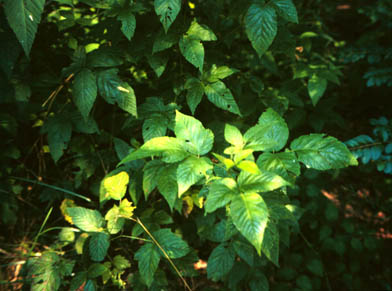
Cane arrangement

Compound Leaves
Rubus argutus Link
Nancy Tilden Campbell
Common Blackberry, Whitfield Thornless, Highbush Blackberry
R. argutus is a tall, erect species of blackberry found in the eastern U.S. along roads and open fields (Jennings,1988). The classification follows. It was first identified by Johann Heinrich Friedrich Link (1767-1851). He donated his collection to the herbarium in Berlin and it has since been destroyed (Stafleu, 1981). The shrub has arching, thorny canes, compound leaves with 3 or 5 oval, toothed leaflets and five-petaled flowers that bloom in April and May. The fruit is juicy and black. Its clearest identifiable characteristic is slightly curved thorns (Alderman, 1997). The canes are sparsely thorned, glandular, and glabrous with inflorescences. These features may have come from an extinct ancestor with 56 chromosomes, R. lemerus (Brown, 1943).
R. argutus is the most common species of wild blackberry in the lower altitudes of the Blue Ridge Parkway (Alderman, 1997). It is ubiquitous on the roadsides and fields of the southeastern United States and Louisiana and Arkansas, and is found at Sam's Farm (pers obs).
Distribution of R. argutus in Georgia:
Growth and fruit production for R. argutus and R. idaeus strigosus is influenced by light, temperature, day length, soil moisture, and wind. Wind can break the canes, and during winter when the canes are dormant, they can become dessicated and die. The blackberries can grow in poor soils (Hellyer, 1982). Raspberries prefer richer soil. Blackberries do not thrive in wet soil, which may be due to an increase in pathogens. Brambles can survive wide temperature changes because they become dormant in the winter. Blackberries are safe to 0 F; raspberries to –20 F. However late spring frosts may kill flowers. Light is the energy source and the growth, productivity, and fruit quality increase with the amount of light (Agnello et al, 1989).
The life cycle for both species is the same. The root system is perennial while the individual canes are biennial. The roots are shallow. Most are in the top 10 inches of soil. They produce shoot buds that grow to the surface and become canes. New canes may also form at the base of the existing canes. These are more vigorous that the root suckers. During the first year, the canes are known as primocanes. They grow rapidly throughout the summer producing leaves and axillary buds at intervals called nodes. During the first year no branching occurs. Elongation ceases as days shorten and temperatures fall. Axillary buds change from vegetative to reproductive or flower buds. This is called differentiation (Agnello et al, 1989). Dormancy now gradually sets in. The time is determined by conditions during the growing season and the age of the plant. Water moves from the canes to the roots. As the next growing season begins, the axillary buds elongate and form fruiting shoots. This is where the flowers form and subsequently, the fruits. Self-pollination occurs mainly by honey bees. Drupelets are formed around the receptacle (Jennings, 1988).
To find good specimens of R. argutus, go to Sam's Farm and pull inside the fence. Many established blackberry plants are growing on the edge of the woods, and young plants are covering the old field. R. argutus can also be observed easily on both sides of GA 316 where woods were cleared to build the road. They are on the tops of banks up and down the highway.

Cane arrangement

Compound Leaves